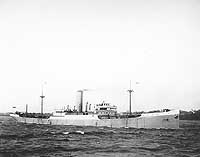

Midwestern barges were hitting the beaches of Normandy. Over early morning radios came the news that it was D-Day. The following June 6 the reason for the frantic orders became clear. Wheels were jerked away and the barges slid into the water. Just one day before the demolition was to start, clouds rolled out of the west and the rains came. The Navy made its plan to destroy the bridges. As former highway commissioner of Kansas, Darby couldn't help thinking of the wreckage on Missouri's fine highway. Somebody was in a whale of a rush over something. To that the high command responded with the order to cut off the bridge structures, tear out bridges and build temporary replacements, if necessary. On second thought it occurred to local naval officers that they couldn't get through the bridge structures (because the barges were wider than the bridges). The L.C.T.s were wider than the highway, but wheels were provided. Then came the grotesque order to put the big ocean-going ships on wheels. The screams were heard all the way from Washington. but when it finally arrived the net effect on the river was 1 inch. Peck dam far up the river in Montana and ordered the water released. Navy officials in Washington were frantic at the delay. Sixty barges built in Greater Kansas City and Leavenworth were tied up at Darby's docks by low water. It is recounted in City of The Future by Haskell and Fowler. After the war Harry Darby told the story of a crisis early in January 1944. Two thousand ships were built and went down the ways at the confluence of the Missouri and Kaw Rivers, and made the 1,000-mile trip to the Gulf of Mexico, where they were sent in convoys to points all over the world. The Darby Corporation built and launched an ocean-going vessel a day for the U.S. Sam Ray Postcard Collection (SC58)See finding aid: Postcard of a boat launch by the Darby Corporation, U.S.


 0 kommentar(er)
0 kommentar(er)
